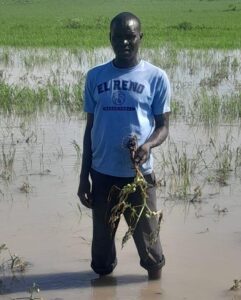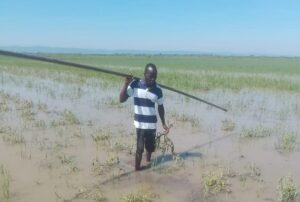Kenyan floods: an update
News
Kenya has suffered widespread flooding in recent weeks, with 267 people killed and 300,000 displaced, according to the Kenyan National Disaster Operations Centre.
Many people are still missing, although all Practical Action staff are safe and accounted for.
Flooding has significantly affected many communities we work with. Many people have lost family members and had their homes and businesses damaged or destroyed.
In western Kenya, where we are working with young rural entrepreneurs, farms have been flooded, and agricultural supply chains hugely disrupted as a result of damaged and impassable roads.
In Turkana County, northern Kenya, where we work with communities facing long term drought, flooding has caused damage to crops, farm fences, irrigation and water supply pipes and delayed progress on borehole excavation.
In Central and western Kenya, where we work with clean cooking entrepreneurs, roads and equipment, such as stoves and kilns, have been severely damaged. This has broken supply chains and reduced demand and supply of products.
Field activities are operational, but there are additional restrictions and risk assessments in place while the flooding situation continues.

Simon Odhiambo stands in one of his flooded fields, also in Kisumu County
We are continuing to assess damage to all the communities we work with and the activities we do, including in the Resilient Agriculture that Works for Young People (RAY) project and our clean cooking programme. We will be assessing if we can provide emergency support.
Tim Mwangi, Head of Programmes Delivery for Practical Action in Kenya said: “It has been quite devastating to see the impact of flooding on the people we have been working with. Many are facing substantial losses and will feel like they are back to square one.
“The flooding this year has been unprecedented. But this is the new climate reality we face, and it emphasises the importance of the work Practical Action does to increase resilience to extreme weather – be that flooding, drought or heatwaves.
“We are more determined than ever to continue to support young, rural entrepreneurs and local governments so that they can thrive, even in the most challenging conditions.”
While the rains have decreased in the past week, the meteorological office forecasts further heavy rainfall in parts of the country, including Nairobi and regions where we have programmes. We are monitoring the situation to ensure the safety and wellbeing of staff and project participants wherever possible.

Caleb Kure, a tomato farmer in Kisumu County counts losses caused by flooding
Currently, all Practical Action offices, in Nairobi, Kisumu and Lodwar are open and staff are working as usual, although many are working from home while flood damage to roads is being addressed.
Practical Action is part of the Zurich Flood Resilience Alliance, and is working across all of our regions to ensure communities vulnerable to flooding are better able to prepare for it and minimise losses.
This programme does not currently cover Kenya, but many of the approaches and learning made in the Zurich programme are relevant to the situation.
Anyone interested in working with Practical Action in Kenya on climate resilience, should contact Tim Mwangi, head of programme delivery on +254 20 2595 311